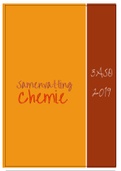Summary
Chemie samenvatting examencommissie 3ASO 2019
chemie samenvatting examencommissie 3ASO 2019 :Deeltjesmodel : Atoombouw Atoommodel van Bohr-Sommerfield Orbitalen Kwantumgetallen Uitsluitingsprincipe van Pauli Regel van Hund
Structuur elektronenmantel Diagonaalregel Verband elektonenconfiguratie en opbouw PSE
Elektronenconfiguratie Valentie-ele...
[Show more]
Preview 4 out of 40 pages
Uploaded on
March 13, 2019
Number of pages
40
Written in
2018/2019
Type
Summary
Institution
Examencommissie/middenjury
Education
Wetenschappen-Wiskunde
Course
Chemie
All documents for this subject (2)
By: aimeepatiwael • 3 year ago
By: nelsonbonsu • 4 year ago
By: surayavanmaele • 5 year ago
By: robbeverhelst • 5 year ago
$9.23
100% satisfaction guarantee
Immediately available after payment
Both online and in PDF
No strings attached
,INHOUD





